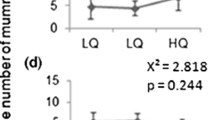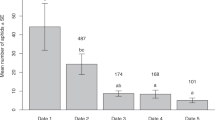Abstract
Generalists and specialists use different cues to find their habitat and essential resources. While generalists have the advantage of exploiting a wider range of resources, they are predicted to be less efficient in using one particular resource compared to specialists. The level of specialization of parasitoids can be either at the habitat or at the host level; strategies used by either type are expected to differ. We examined interactions between three aphid parasitoid species that are a habitat specialist Aphidius rhopalosiphi, a habitat generalist Aphidius ervi, and a host generalist Praon volucre on three cereal aphids, Sitobion avenae, Metopolophium dirhodum and Rhopalosiphum padi. We compared total parasitism rate across behavioral and physiological variation in a non-choice test. Next, we addressed total parasitism in two phases to examine: (1) the response of parasitoids to different hosts through the behavioral sequence from antennation through oviposition, and (2) the physiological suitability of different hosts for oviposition and larval development. Parasitization typically involved the following behavioral steps: (1) antennal contact, (2) abdominal bending, and (3) ovipositor insertion (acceptance). A. rhopalosiphi had the same number of antennal contacts with the three aphids but showed fewer instances of abdominal bending towards R. padi. Pre-contact host preference was found for A. ervi but it did not correspond to the level of acceptance. The number of antennal contacts by P. volucre corresponded to the parasitization level of the aphid species but more mummies were produced on M. dirhodum than on R. padi. These results suggest that parasitoid species that are habitat specialists react similarly to the different host species present in the same habitat, whereas generalist species exhibit clear preferences during host selection. Preferences were, however, not always related to host suitability.
Similar content being viewed by others
References
Battaglia D, Pennachio F, Poppy G, Powell W, Romano A, Tranfaglia A (1997) Physical and chemical cues regulating the oviposition behaviour of Aphidius ervi (Hymenoptera: Braconidae). Bol Asoc Esp Entomol Suppl 21:114–115
Bonsall MB, Jansen VAA, Hassell MP (2004) Life history trade-offs assemble ecological guilds. Science 306:111–114
Braimah H, van Emden HF (1994) The role of the plant in host acceptance by the parasitoid Aphidius rhopalosiphi (Hymenoptera: Braconidae). Bull Entomol Res 84:303–306
Chow A, Mackauer M (1991) Patterns of host selection by four species of aphidiid (Hymenoptera) parasitoids: influence of host switching. Ecol Entomol 16:403–410
Christensen R (1990) Log-linear models. Springer, New York
Clark JS, Dietze M, Chakraborty S, Agarwal PK, Ibanez I, LaDeau S, Wolosin M (2007) Resolving the biodiversity paradox. Ecol Lett 10:647–662
Dean GJ, Jones GJ, Powell W (1981) The relative abundance of the hymenopterous parasites attacking Metopolophium dirhodum (Walker) and Sitobion avenae (F.) (Hemiptera: Aphididae) on cereals during 1973–1979 in southern England. Bull Entomol Res 71:307–315
Egas M (2005) Evolution of specialization and ecological character displacement: metabolic plasticity matters. In: Reydon TAC, Hemerik L (eds) Current themes in theoretical biology. Springer, The Netherlands, pp 281–304
Egas M, Dieckmann U, Sabelis MW (2004) Evolution restricts the coexistence of specialists and generalists: the role of trade-off structure. Am Nat 163:518–531
Egas M, Sabelis MW, Dieckmann U (2005) Evolution of specialization and ecological character displacement of herbivores along a gradient of plant quality. Evolution 59:507–520
Eggleton P, Gaston KJ (1990) “Parasitoid” species and assemblages: convenient definitions or misleading compromises? Oikos 59:417–421
Feener DH, Brown BV (1997) Diptera as parasitoids. Annu Rev Entomol 42:73–98
Gardner SM, Ward SA, Dixon AFG (1984) Limitation of superparasitism by Aphidius rhopalosiphi: a consequence of aphid defensive behaviour. Ecol Entomol l9:149–155
Glinwood RT, Smiley DWM, Hardie J, Pickett JA, Powell W, Wadhams LJ, Woodcock CM (1999) Aphid sex pheromones: manipulation of beneficial insects for aphid population control. J Pestic Sci 55:208–209
Hagvar EB, Hofsvang T (1991) Aphid parasitoids (Hymenoptera, Aphidiidae): biology, host selection and use in biological control. BNI 12:13–41
Hand SC (1989) The overwintering of cereal aphids on Gramineae in southern England, 1977–1980. Ann Appl Biol 115:17–29
Höller C, Borgemeister C, Haardt H, Powell W (1993) The relationship between primary parasitoids and hyperparasitoids of cereal aphids: an analysis of field data. J Anim Ecol 62:12–21
Jones MG (1979) Observations on primary and secondary parasites of cereal aphids. Entomol Month Mag 115:61–71
Jonsen ID, Fahrig L (1997) Response of generalist and specialist insect herbivores to landscape spatial structure. Landsc Ecol 12:185–197
Langer A, Stilmant D, Verbois D, Hance T (1997) Seasonal activity and distribution of cereal aphid parasitoids in Belgium. Entomophaga 42:185–191
Le Ralec A, Rabasse JM (1988) Structure, sensory receptors and operation of the ovipositor of three Aphidiidae. In: Niemczyk E, Dixon AFG (eds) Ecology and effectiveness of Aphidophaga. Academic Publishing, The Hague, pp 83–88
Ma J, Levin SA (2006) The evolution of resource adaptation: how generalist and specialist consumers evolve. B Math Biol 68:1111–1123
Mackauer M (1983) Determination of parasite preference by choice tests: the Aphidius smithi (Hymenoptera: Aphidiidae)—pea aphid (Homoptera: Aphididae) model. Ann Entomol Soc Am 76:256–261
Memmott J, Martinez ND, Cohen JE (2000) Predators, parasitoids and pathogens: species richness, trophic generality and body sizes in a natural food web. J Anim Ecol 69:1–15
Michaud JP, Mackauer M (1994) The use of visual cues in host evaluation by aphidiid wasps. I. Comparison between three Aphidius parasitoids of the pea aphid. Entomol Exp Appl 70:273–283
Moreno-Mari J, Dominguez-Romero M, Oltra-Moscardo MT, Jimenez-Peydro R (1999) Phytophagous and natural enemies associated with aromatic plants in glasshouse. Ann Soc Entomol Fr 35:521–524
Powell W, Wright AF (1988) The abilities of the aphid parasitoids Aphidius ervi Haliday and A. rhopalosiphi De Stefani Perez (Hymenoptera: Braconidae) to transfer between different known host species and the implications for the use of alternative hosts in pest control strategies. Bull Entomol Res 78:683–693
Powell W, Pennacchio F, Poppy GM, Tremblay E (1998) Strategies involved in the location of hosts by the parasitoid Aphidius ervi Haliday (Hymenoptera: Braconidae: Aphidiinea). Biol Control 11:104–112
SAS Institute (1989) SAS user’s guide: statistics. SAS Institute, Cary
Singer MS, Stireman JO (2003) Does anti-parasitoid defense explain host-plant selection by a polyphagous caterpillar? Oikos 100:554–562
Stamp NE, Bowers MD (1992) Foraging behavior of specialist and generalist caterpilars on plantain (Plantago lanceolata) altered by predatory stinkbugs. Oecologia 92:596–602
Stilmant D (1994) Differential impact of three Sitobion avenae parasitoids. Norw J Agric Sci Suppl 16: 89-99
Stilmant D (1997) Parasitoid adaptation to their hosts. Model composed by the main cereal aphid parasitoids (Hymenoptera: Aphidiidae) and by their hosts (Homoptera: Aphididae). PhD thesis, Université Catholique de Louvain, Louvain-la-Neuve
Stilmant D, Boivin G, Hance T (1994) Attractiveness and acceptability of Sitobion avenae (Aphididae: Homoptera) for Aphidius rhopalosiphi and A. ervi (Aphidiidae: Hymenoptera). Med Fac Landbouww Rijksuniv Gent 592b:717–724
Stireman JO, Singer MS (2003) What determines host range in parasitoids? An analysis of a tachinid parasitoid community. Oecologia 135:629–638
Strickler K (1979) Specialization and foraging efficiency of solitary bees. Ecology 60:998–1009
van Baaren J, Boivin G, Nenon JP (1994) Intra and interspecific host discrimination in two closely related egg parasitoids. Oecologia 100:325–330
Vet LEM, Dicke M (1992) Ecology of infochemical use by natural enemies in a tritrophic context. Annu Rev Entomol 37:141–172
Vickerman GP (1982) Distribution and abundance of cereal aphid parasitoids (Aphidius spp.) on grassland and winter wheat. Ann Appl Biol 101:185–190
Vinson SB (1998) The general host selection behavior of parasitoid Hymenoptera and a comparison of initial strategies utilized by larvaphagous and oophagous species. Biol Control 11:79–96
Vorley WT (1986) The activity of parasitoids (Hymenoptera: Braconidae) of cereal aphids (Hemiptera: Aphididae) in winter and spring in southern England. Bull Entomol Res 76:491–504
Wickremasinghe MGV, van Emdem HF (1992) Reactions of adult female parasitoids, particularly Aphidius rhopalosiphi, to volatile chemical cues from the host plants of their aphid prey. Physiol Entomol 17:297–304
Acknowledgements
We thank J.-M. Rolin and the late Prof G. Gérard for their statistical advice. Many thanks to Renate Wesselingh and Hans Van Dyck for their comments on the manuscript. Financial support was provided by the Belgian National Fund for Scientific Research, FNRS. This is paper BRC 122 of the Biodiversity Research Center, UCL.
Author information
Authors and Affiliations
Corresponding author
Additional information
Communicated by Wolfgang Weisser.
Rights and permissions
About this article
Cite this article
Stilmant, D., Van Bellinghen, C., Hance, T. et al. Host specialization in habitat specialists and generalists. Oecologia 156, 905–912 (2008). https://doi.org/10.1007/s00442-008-1036-8
Received:
Accepted:
Published:
Issue Date:
DOI: https://doi.org/10.1007/s00442-008-1036-8




